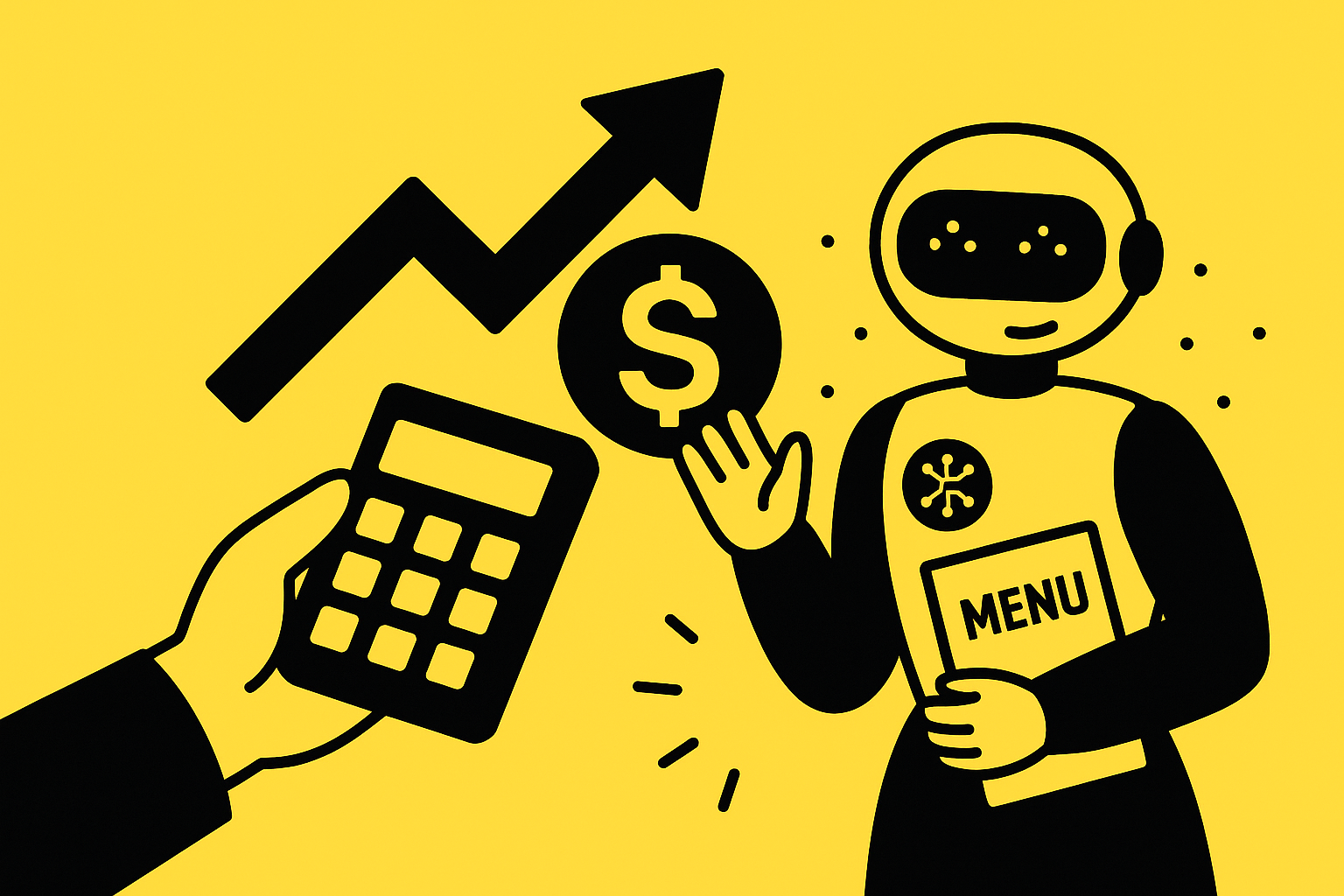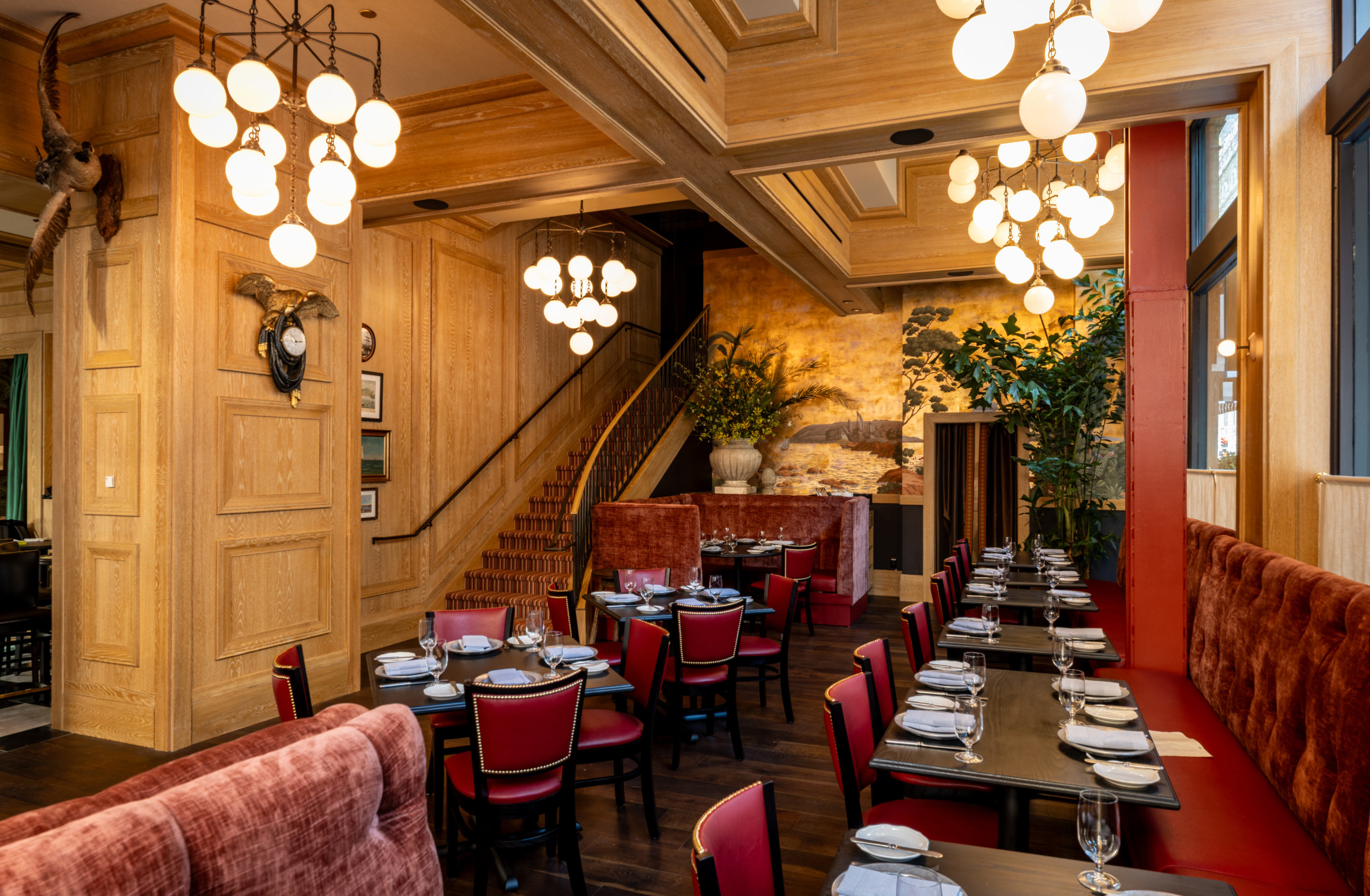
The restaurant industry is experiencing a seismic shift as artificial intelligence transforms front-of-house operations. (Hostie AI) With labor shortages plaguing the hospitality sector and operational costs climbing, restaurant operators are turning to AI hostess solutions that promise substantial returns on investment. (Tech-Savvy Hospitality)
The numbers are compelling: AI hosts are generating additional revenue of $3,000 to $18,000 per month per location, up to 25 times the cost of the AI host itself. (Hostie AI) Meanwhile, industry leaders report ROI figures ranging from conservative 352% models to impressive 760% benchmarks, making AI hostess solutions one of the most attractive investments in restaurant technology today.
This comprehensive ROI calculator guide will help you understand exactly how an AI hostess can transform your labor costs, boost revenue, and deliver measurable returns. We'll explore real-world scenarios, break-even timelines, and provide interactive tools to calculate your specific ROI based on your restaurant's unique metrics.
The hospitality industry faces an unprecedented staffing crisis. Low pay, high stress, worker competition, and reluctance from those laid off during the pandemic to return, combined with poor working conditions, have led to a chronic shortage of entry-level staff. (Hostie AI) The COVID-19 pandemic resulted in the loss of more than 670,000 hotel industry operation jobs and nearly 4 million hospitality jobs in 2020. (Tech-Savvy Hospitality)
Despite the return of dining and travel businesses, the hospitality industry continues to grapple with significant labor shortages. (Tech-Savvy Hospitality) This has forced restaurant operators to explore technological solutions that can maintain service quality while reducing dependency on human staff for routine tasks.
As competition for workers intensifies, wage pressures continue to mount. Restaurant operators are finding themselves caught between the need to offer competitive compensation to attract staff and the pressure to maintain profitability. This economic squeeze has made AI solutions increasingly attractive as a way to optimize labor allocation and reduce overall staffing costs.
Artificial intelligence is making significant inroads into restaurant front-of-house operations. (Hostie AI) Companies like Hostie are not just managing bookings; they are engaging in natural conversations, handling multiple languages, and showcasing soft skills previously thought to be exclusive to humans. (Hostie AI)
The conservative 352% ROI model represents a realistic baseline for most restaurant operations. This calculation typically factors in:
The 760% ROI benchmark, referenced by industry leaders like SoundHound, represents the upper end of potential returns. This higher figure typically includes:
The wide range between 352% and 760% ROI reflects several variables:
To calculate your restaurant's specific AI hostess ROI, you'll need to gather the following data:
Annual Savings = (Hourly Wage × Hours/Week × 52 weeks × Burden Rate) + Recruitment Costs + Training Costs
Additional Revenue = (Missed Calls Recovered × Average Ticket) + (Upselling Increase × Monthly Orders) + (Extended Hours Revenue)
ROI = ((Annual Savings + Additional Revenue - AI Service Cost) / AI Service Cost) × 100
Restaurant Profile:
ROI Calculation:
| Cost/Benefit Category | Annual Amount |
|---|---|
| Labor cost savings | $40,560 |
| Recruitment/training savings | $3,200 |
| Recovered missed calls revenue | $16,425 |
| Extended hours revenue | $8,760 |
| Total Benefits | $68,945 |
| AI service cost | $14,400 |
| Net Benefit | $54,545 |
| ROI | 379% |
Break-even Timeline: 3.1 months
Restaurant Profile:
ROI Calculation:
| Cost/Benefit Category | Annual Amount |
|---|---|
| Labor cost savings (10 locations) | $432,000 |
| Recruitment/training savings | $48,000 |
| Recovered missed calls revenue | $280,800 |
| Extended hours revenue | $156,000 |
| Upselling enhancement | $97,500 |
| Total Benefits | $1,014,300 |
| AI service cost (10 locations) | $144,000 |
| Net Benefit | $870,300 |
| ROI | 604% |
Break-even Timeline: 2.0 months
Hostie is an AI for restaurants, made by restaurants. (Hostie AI) The AI integrates directly with the tools you're already using – existing reservation systems, POS systems, and even event planning software. (Hostie AI) This seamless integration eliminates the need for staff to learn new systems or manage multiple platforms, reducing training costs and implementation friction.
The tool doesn't just answer calls – it's built to learn the nuances of restaurant hospitality and engage with all of your systems, to feel like a natural and essential addition to your operations. (Hostie AI) Modern AI hosts can enhance efficiency, personalization, and guest satisfaction by engaging in natural conversations across multiple languages, handling bookings without human intervention, and remembering guest preferences and special occasions. (Hostie AI)
In multicultural cities like Toronto and Montreal, AI systems offer a distinct advantage with their multilingual capabilities, enabling smoother communication with diverse clientele and enhancing the overall customer experience. (Hostie AI) Hostie's AI can fluently speak 20 languages, catering to both tourists and locals. (Hostie AI)
Unlike human staff, AI hostess solutions provide round-the-clock service, managing waitlists dynamically, providing real-time updates on table availability, cross-selling special events and promotions, and addressing dietary restrictions and special requests. (Hostie AI) This extended availability directly translates to additional revenue opportunities that would otherwise be missed.
In June 2025, Dine Brands, the parent company of Applebee's and IHOP, announced plans to implement artificial intelligence in their restaurants. (Smart Service Revolution) Dine Brands is testing Voice AI Agents to handle customer orders over the phone, aiming to streamline operations and reduce stress on human staff. (Smart Service Revolution) This move represents a significant step in the restaurant industry's adoption of Non-Human Workers to manage high call volumes and labor shortages. (Smart Service Revolution)
AI assistants are already in use by early adopters, often without guests realizing it. (Hostie AI) Business owners using AI solutions report the potential to earn up to $30,000 more per month per location. (Newo AI) These results demonstrate that the technology has moved beyond experimental phases into proven, revenue-generating implementations.
Contrary to fears of job displacement, many restaurants find that AI hosts complement human staff. (Hostie AI) The technology handles routine tasks like basic reservations and order taking, freeing human staff to focus on complex customer service, relationship building, and the personal touches that define exceptional hospitality.
Restaurants that can implement AI hostess solutions quickly see faster returns. Systems like Newo.ai allow restaurants to create their AI host in one click within minutes, and can be implemented in under an hour by feeding it the restaurant's menu, signature dishes, and reservation schedules. (Hostie AI)
Establishments with higher existing labor costs typically reach break-even faster. The calculation is straightforward: the higher your current hosting costs, the more dramatic your savings will be.
Restaurants with high call volumes and significant missed call rates see the most immediate impact. Each recovered call represents potential revenue that directly contributes to ROI.
| Restaurant Type | Average Break-Even | Key Factors |
|---|---|---|
| Quick Service (QSR) | 2-4 months | High call volume, standardized processes |
| Casual Dining | 3-6 months | Moderate complexity, reservation focus |
| Fine Dining | 4-8 months | Complex requests, higher service standards |
| Multi-location Chains | 1-3 months | Economies of scale, standardized operations |
Ensure your AI hostess integrates with all existing systems. Hostie integrates seamlessly with existing reservation and POS systems, enhancing operational efficiency and customer satisfaction. (Hostie AI) This integration eliminates data silos and ensures consistent customer experiences across all touchpoints.
While AI reduces training needs for routine tasks, staff should be trained to work alongside AI systems effectively. Focus training on complex customer service scenarios and relationship building that AI cannot replicate.
Regularly review AI performance metrics and adjust settings to improve outcomes. Monitor call resolution rates, customer satisfaction scores, and revenue attribution to identify optimization opportunities.
AI-powered chatbots can help with personalized ordering, while predictive analytics can aid inventory management. (The Role of AI in Restaurants) These capabilities help restaurants optimize operations beyond just call handling.
Advanced AI systems remember guest preferences and special occasions, enabling personalized service that drives customer loyalty and repeat business. This personalization capability directly impacts customer lifetime value and long-term ROI.
Sophisticated AI can adjust recommendations based on demand patterns, inventory levels, and customer history, maximizing revenue per interaction.
Every missed call represents potential lost revenue. AI systems answer 100% of calls, ensuring no opportunities are lost due to busy staff or after-hours timing.
AI enables restaurants to take reservations and orders 24/7 without additional labor costs, capturing revenue during traditionally closed hours.
AI can be programmed with sophisticated upselling strategies, consistently suggesting add-ons, upgrades, and complementary items that human staff might forget or feel uncomfortable promoting.
AI systems generate valuable customer data that can inform menu decisions, pricing strategies, and marketing campaigns. This data-driven approach can significantly impact long-term profitability.
AI ensures consistent brand messaging and service quality across all customer interactions, protecting brand reputation and customer experience.
As restaurants grow, AI systems scale effortlessly without proportional increases in labor costs, making expansion more profitable.
Artificial Intelligence is expected to be a game-changer for restaurants in 2024, optimizing operations and enhancing customer experiences. (The Role of AI in Restaurants) As AI technology continues to evolve, early adopters will benefit from continuous improvements and new capabilities without additional investment.
The global food service market was valued at $2.52 trillion in 2021 and is projected to reach $4.43 trillion by 2028. (Artificial Intelligence-Driven Personalization) This growth, combined with ongoing labor challenges, suggests that AI adoption will accelerate, making early implementation a competitive advantage.
In just a couple of years, there will hardly be any business that hasn't hired an AI employee. (Hostie AI) Restaurants that implement AI hostess solutions now will be positioned ahead of competitors who wait, capturing market share and operational advantages.
The evidence is clear: AI hostess solutions deliver substantial returns on investment, with ROI figures ranging from conservative 352% models to impressive 760% benchmarks. The key to maximizing your returns lies in understanding your specific operational context, implementing the technology effectively, and continuously optimizing performance.
Whether you're operating a single-unit café or managing a multi-location restaurant group, AI hostess solutions offer a proven path to reducing labor costs while enhancing customer service. The break-even timelines are typically measured in months, not years, making this one of the most attractive technology investments available to restaurant operators today.
As the hospitality industry continues to grapple with labor shortages and rising costs, AI solutions like Hostie provide a sustainable competitive advantage. (The Paradox of Progress) By automating routine tasks while preserving the human touch where it matters most, restaurants can achieve operational efficiency without sacrificing the hospitality that defines great dining experiences.
The question isn't whether AI will transform restaurant operations – it's whether you'll be an early adopter capturing maximum benefits or a late follower playing catch-up. With ROI potential of 300-760% and break-even timelines as short as 2-3 months, the financial case for AI hostess implementation has never been stronger.
Start your ROI calculation today, and discover how an AI hostess can transform your restaurant's profitability while enhancing the guest experience that keeps customers coming back.
AI hostess solutions deliver exceptional ROI through multiple cost savings and revenue streams. They eliminate the need for dedicated host staff (saving $25,000-$40,000 annually per position), reduce missed calls that cost restaurants an average of $50-$200 per lost reservation, and operate 24/7 without breaks or sick days. Additionally, AI systems like Hostie can handle multilingual customers in 20 languages, expanding market reach and increasing bookings significantly.
The primary cost savings include elimination of host labor costs ($25,000-$40,000 per year), reduced training expenses, zero sick leave or vacation coverage costs, and decreased missed reservation revenue. AI hostess systems also reduce phone system maintenance costs and eliminate the need for multiple staff members to handle peak call volumes. For multi-location restaurants, these savings multiply across all locations while using a single AI system.
Most restaurants see break-even within 3-8 months depending on their size and call volume. Single-unit cafés typically recover their investment in 6-8 months, while high-volume restaurants and multi-location groups can see payback in as little as 3-4 months. The ROI accelerates after the break-even point, with many establishments reporting 300-760% returns within the first year of implementation.
Yes, modern AI hostess solutions like Hostie integrate seamlessly with major reservation systems and leading POS systems. This integration allows for real-time booking management, order placement, and customer data synchronization. The AI can handle calls, texts, emails, reservations, and orders through a unified platform, eliminating the need for staff to manage multiple systems manually.
Hostie is specifically designed by restaurants for restaurants, understanding the unique challenges of hospitality operations. Their AI assistant Jasmine is multilingual, speaking 20 languages fluently to serve both tourists and locals. Unlike generic AI solutions, Hostie focuses exclusively on restaurant needs, offering 24/7 management of bookings and orders with deep integration into restaurant-specific systems and workflows.
Absolutely. Single-unit cafés typically see 300-400% ROI through basic labor cost savings and improved order accuracy. Mid-size restaurants achieve 400-600% ROI by capturing more reservations and reducing no-shows. Large restaurant groups and high-volume establishments can reach 600-760% ROI through economies of scale, managing multiple locations with one AI system, and maximizing revenue during peak hours when human staff would be overwhelmed.
RELATED


